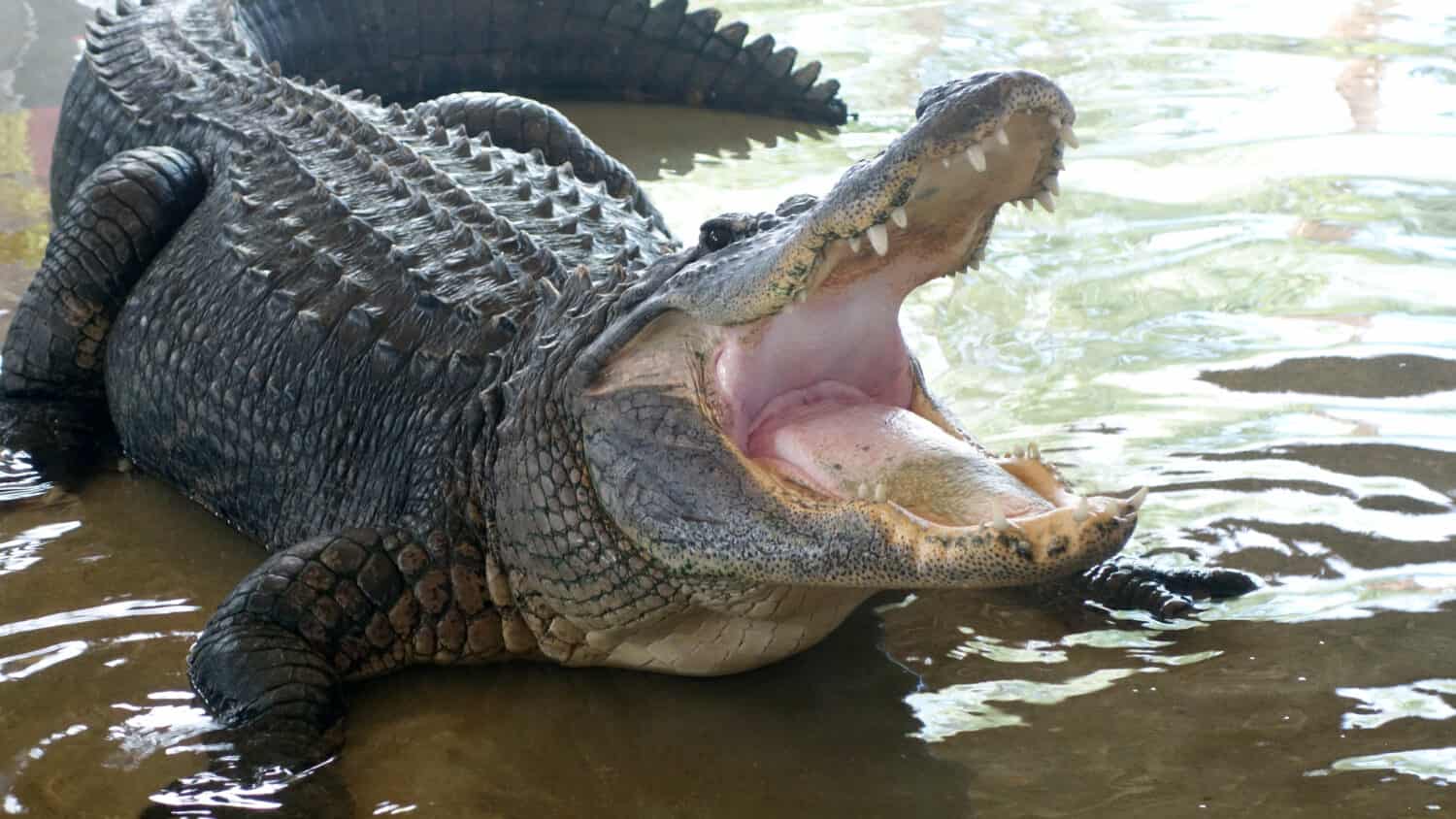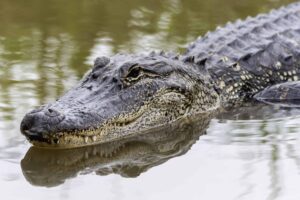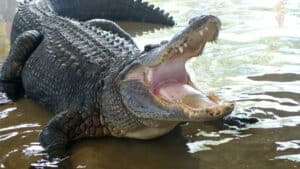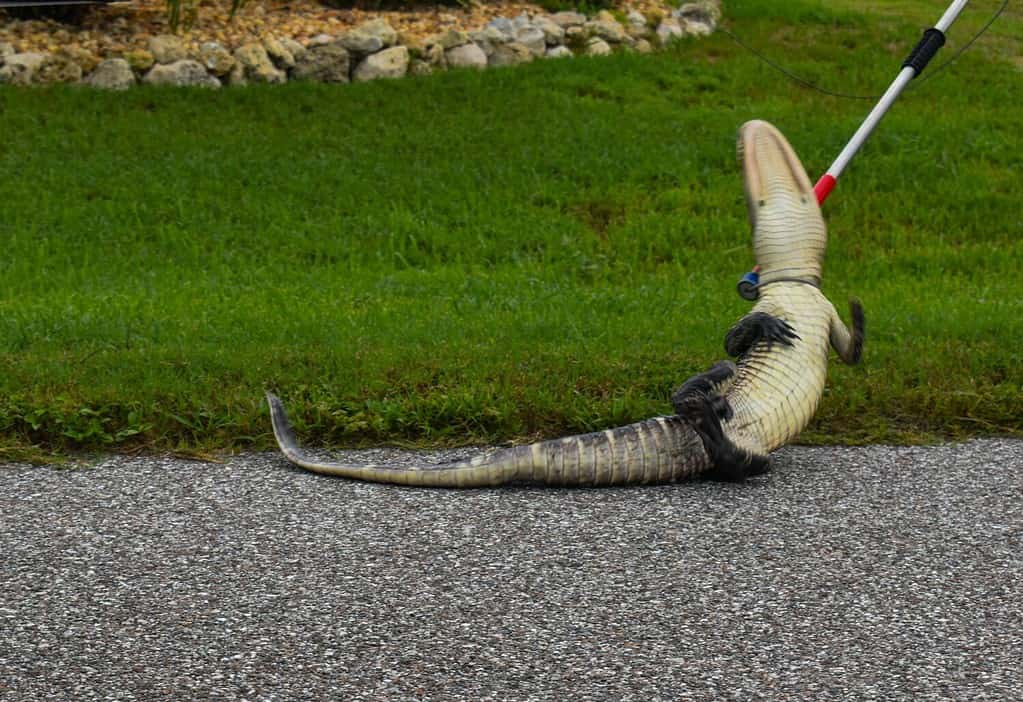
Alligators this small may be fairly easy to catch, but the bigger beasts in the water put up quite a fight.
©SuJo Studios/Shutterstock.com
Alligator hunting in Florida is a passion and a way of life. During the alligator hunting season, you can expect the same level of energy and excitement as you’d expect during football season, if not more.
It makes sense that any visitor or resident in Florida would want to give this sport a try at least once. However, before you apply, you need to understand the application process and what to expect.
Keep reading below to figure out how to get a taste of the action of alligator hunting in Florida.
Alligator Hunting Season

Alligator hunting season changes a little from state to state, so it’s important you understand the times for your specific area.
©Wildnerdpix/Shutterstock.com
The hunting season in Florida stretches out over 11 weeks. However, these weeks are broken up, so that some people can only hunt at certain times of the season.
Specific Hunting Times
The first four weeks of alligator hunting season in Florida make up specific hunting times. For those who applied for tags in the first three weeks of the application process, they are given a specific week where they can hunt.
The time you are given depends on your preferences and the availability. You’ll be given a one-week period where you’re allowed to hunt and fill up your tags. The other weeks are then reserved for other tag members. This helps to regulate the hunting season and stops everyone from rushing out in the first few weeks to try and find the biggest alligator.
These weeks are usually from the middle of August until the middle of September. Make sure you check all of your information carefully to ensure you’re hunting in the right week.
Open Season
After those four weeks, the hunting season then opens up. You still need alligator hunting permits to hunt, but anyone is allowed to hunt during these seven weeks. Those who got their tags late, or weren’t able to get both of their tags filled in their week can now continue to go and hunt.
This usually starts around the middle of September and goes on until the first day of November.
How to Apply For Alligator Tags in Florida
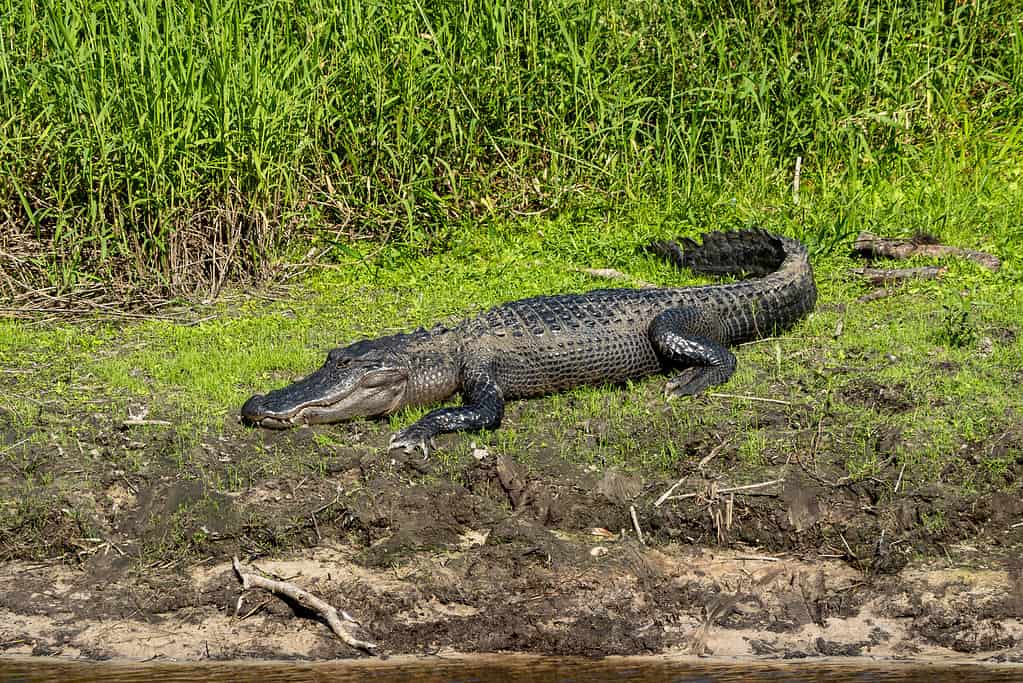
American alligators are common in the southern states, such as Florida.
©FlagtailsPhotography/iStock via Getty Images
The applications open up in May and run through June. During that period, there are actually four application periods.
This means you have four chances to apply. Each application period opens up at 10 am Eastern Time on the first day and runs until 11:59 pm on the last day. The dates change a little but generally run from May 5 until June 25. The first three weeks are applications for the limited weekly hunting periods.
The last application period is called leftovers. Though it often ends pretty early due to the high volume of people applying, it will stay open until the final hunt date or until the hunting tags are all handed out.
To apply, you go to the Florida Wildlife Conservation page focused on alligator harvesting.
You can apply for permits during any of the first three phases. However, if you get a permit during these periods, you can’t apply again until Phase IV. For the leftovers phase, you’re allowed to apply again, even if you have permits from one of the first three phases.
Kinds of Tags You Can Get
There are two main kinds of tags you can get. They are broken up into two groups, which are the management units and county units. You get to pick up to 12 of your favorite places and times to hunt. Pick as many as you want, but make sure you want to hunt in them.
The 12 choices don’t only account for locations but for ideal hunting times. Every choice you list includes both a location and your preferred hunting week.
While you can pick the same area multiple times with different time periods, there’s no point in picking the same area and time period more than once. It doesn’t improve your chances any.
Additionally, you want to list your choices in order of preference. If there are some limited hunting areas you really want to try out, it’s best to list them before you list your other choices. It’s recommended you list your 12 options in order of preference and with the more limited hunting options first.
Management Unit
Management units are small hunting areas. Instead of having several bodies of water to try and catch a gator, you get specific sections of a river or a certain lake to hunt in. There are a total of 63 harvest units throughout the state.
Depending on the body of water, there may be anywhere from 2 to 350 tags handed out for a specific management unit.
Most of the units are located in the south and central parts of Florida, but there are five locations within the panhandle as well. Each management unit has a three-digit code ranging from 101 to 751. When you apply for a tag in these areas, you will use that three-digit code, as well as an additional number at the end for the specific period you want to harvest in.
For example, Peace River North is code 119. If you want to go in the second hunting window, you would apply for location 1192.
Some of these areas have specific harvesting guidelines on top of other guidelines as well. For example, some areas may not be open until duck hunting season ends. Others only allow night hunting, and others still only allow hunting on weekends.
There are other guidelines as well that may be in place such as noise restriction and the type of boat you can use. While your permit will show where you’re able to hunt, it’s a good idea to go online and check out the specific zone so that you know all the rules.
Detailed maps and guidelines are available on the Florida Wildlife page. They are broken down into sections so that you can easily find your area.
County
The other option is to choose a county tag. Out of the 67 counties in Florida, there are only two where you can’t get a county tag. These are Miami-Dade and Monroe.
When you get a county tag, you can hunt in almost any public body of water in that county. You can even hunt in private areas, so long as you have the landowner’s permission.
There are certain areas in the county where you won’t be able to hunt. For one, any of the specific management units above are not open to county tag owners. Additionally, private wetlands and protected public properties are also outside of your hunting range.
Like with management units, each county is given a unit number between 801 and 867. When applying for a certain county, you will look for that three-digit number as well as the number at the end for the harvesting period you want.
The tags permitted at each county range again from 2 to around 400 depending on the gator population. If you want more information about what areas are banned from gator hunting, and which county has which tag, you can check out the Florida Wildlife page listed above in management units.
How Many Tags You Can Get

Alligators can be found in almost every body of water in Florida.
©jaimie tuchman/Shutterstock.com
In Florida, any time you apply, you will get two alligator tags. This means you’ll be able to hunt and dispatch two gators every season you’re selected.
There are some exceptions to this rule, but for the majority of the population, you can expect two tags mailed out to you when you’re selected from the random lottery.
What Happens if You Don’t Use All Your Tags
If you don’t use both of your tags by the end of the open hunting season, you’re less likely to be given tags in the following years. Additionally, even if you get a tag, there’s a chance that you will be given fewer tags
Total Tags Handed Out Each Year
In Florida, there are a total of 7,000 tags handed out every year. These tags are for the entire state, and each hunting area is given a specific number of tags based on the estimated population in the area.
How Many People Apply for Hunting Tags?
Though the total number of people that apply every year changes, there are always more than enough people applying for alligator hunting tags. Over 10,000 people apply for tags in Florida every year. Sometimes, the number can soar past even 15,000. Many of them are citizens, but some people are out of state.
If not all of the tags are handed out for the specific hunting weeks, the open hunting season allows for another chance for people to apply. Any leftover tags will be handed out then.
How Are Tags Handed Out?
Tags are handed out via a lottery system. For the most part, the decision is random, but there are a few factors that can affect your chances.
People who haven’t been picked in several years tend to get a slightly better advantage. Meanwhile, people who didn’t use all their tags in the last hunt are often given much lower priority and have a lower chance of getting picked again.
Phase IV of the application process doesn’t run on a lottery like the first three phases. Instead, it runs on a first-come, first-served basis. Whether you already have permits or not, the first people to apply for the tags will get them, so it’s best to be up and early for this period if you want to take advantage of it.
Since it is just the leftovers, you won’t have as much of a choice over where you hunt. This phase is best for those that don’t mind traveling, or are lucky enough to have a location near them still open.
Cost For Alligator Hunting Licenses

Alligator eyes look like solar systems, but you won’t get much time to appreciate them during a hunt.
©Ruslan Mussin/Shutterstock.com
You’ll want to apply for tags for the alligator hunting season a few months before the season starts. Before the lottery starts, all cards are checked for funds. So it’s important to have the funds available on your card around the time of the drawing.
Any cards without the proper funding will be knocked out of the lottery. If you do see a hold on your card, it isn’t a sign you have gotten the permit, but only that your card is being checked.
For all the prices below, additional handling fees can also apply.
Florida Residents
For Florida residents, the standard price for two tags is $272. If you have a disability, you can apply for as little as $22. However, you need to make sure that your hunting and fishing license for residents with disabilities is updated before you apply for the harvest. Otherwise, you will automatically be charged the full price.
If you already have an alligator trapping license valid for the month, and you are applying for more tags later, two more tags will cost $62.
Non-Florida Residents
For non-residents of the state of Florida, the cost is much higher. Two tags plus the licenses and permits will cost you $1,022.
Agents
You can also apply for the hunting season as an agent. These are for people who want to help assist in catching a gator but don’t want their own permits. Companies that assist with gator hunting can get these, but so can individual friends and family members who want to accompany you on your trip.
It’s important to note that the actual permit and tag holder must always accompany those who just have agent licenses. If someone just wants to come along for the ride, but has no interest in helping catch the gator at all, they don’t need a permit. Holding a light or driving the boat does not count as helping, and therefore, no alligator agent permit is needed.
Anyone 15 or under doesn’t need to get an agent license. Even if they are helping with the hunt, there’s no need to purchase them a license.
These licenses work for the entirety of the state, so you don’t have to pick out specific locations. They cost $52.
When You’ll Get Your Tag
Generally, after the lottery is over for every period, the tags will be sent out. For some individuals, the tag may take up to six weeks to be sent to you.
Laws and Regulations

Feeding alligators is illegal and extremely dangerous as it makes them more used to humans.
©Tande/Shutterstock.com
Requirements For a Permit
It’s worth noting that neither a hunting or fishing license is required to participate in the alligator hunt. There are only two major requirements to get a permit. The first is that you must be 18, or turning 18 before the hunting season starts.
Additionally, applicants can’t have been convicted for the illegal taking of a crocodilian species. This means every species that falls into this category, including alligators and crocodiles. If you are convicted, you must wait five years before applying for the permit.
If the species you were convicted of illegally taking was an endangered species, that period jumps up to 10 years. It must be 10 years before the application process. So if you were convicted on August 10th, 2020, you would have to wait until 2031 to apply again. The same goes for the five-year window.
Alligator Size
Alligators that are caught must not be hatchlings. Other than that, there aren’t any guidelines on the size of the alligator. Most people want bigger alligators, so avoiding hatchlings isn’t usually a problem. The average size of gators caught throughout Florida tends to be about eight feet.
What The Permit Allows
With the permit, you are allowed to catch and dispatch two gators in your selected area during your selected times. They must not be hatchlings and you must follow the proper catching and dispatching methods.
Rules for Catching and Dispatching a Gator
You’re allowed to use a variety of tools to catch a gator. These items include:
- Harpoons
- Artificial lures
- Baited wooden pegs (under 2 inches in length)
- Gigs
- Manually operated spears
- Spearguns
- Pre-charged pneumatic air guns
- Crossbows
You can choose the one or ones that work best for your needs. However, after using one of these methods, gators must be killed immediately. Using baited hooks, gig-equipped bang sticks, or firearms for taking alligators is not allowed.
To kill an alligator, you’re only allowed to use a bang stick as far as firearms go. If you are using a bang stick, then it must be when an alligator is attached to a restraining line.
Any time you are using bait, you have to be in contact with the bait. This means you need to have the bait connected to a line that you are on the other side of at all times.
If you catch an alligator using one of these methods, it must be killed. You are not allowed to catch-and-release unless you’re using snatch hooks or a catch pole. Otherwise, even if it’s not the gator you want, you must kill it.
Alligator Hunting in Florida Tips and Tricks
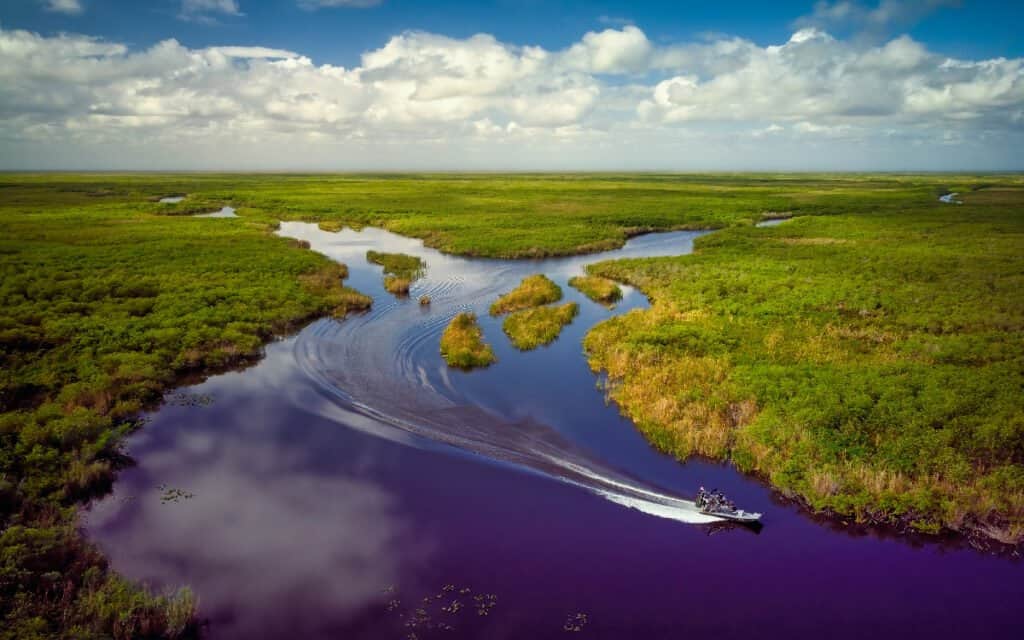
The Everglades is the biggest tropical wilderness in the United States.
©iStock.com/Robert DelVecchio – OcuDrone
Alligators are not considered game animals. That means you’re allowed to use electronic or recorded game calls when you are hunting. This method has often been used in the past and has shown to be an effective way of drawing in alligators.
Additionally, alligators don’t tend to move around much. If you go out scouting before hunting season applications start and you see a good-sized alligator you want to catch, there’s a very good chance it will still be there when it’s time to hunt.
The best way to judge the size of a gator is by looking at the space between their eyes. The more space between their eyes, the larger they likely are. Usually, you want a gap of over four inches for it to be considered an adult alligator. Larger alligators also tend to stay in deeper water more so than small alligators do.
During the day, or if you have a lot of light, another way to estimate the size of an alligator is to look at the distance between their snout and eye. For each inch of space between their eye and snout, you can estimate roughly a foot in length.
So for example, an alligator with eight inches between its snout and eyes is likely right around eight feet long. While these measurements aren’t perfect, they do give you a pretty good estimation.
Thank you for reading! Have some feedback for us? Contact the AZ Animals editorial team.

